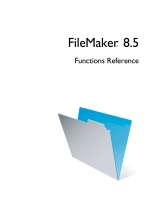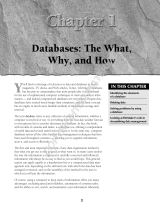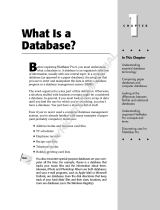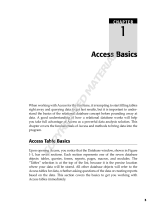
Getting help XIX
Using the FileMaker Pro documentation
This guide and the other documentation in the set give you all the
information you need to know about installing and using FileMaker Pro.
Start by reading chapter 1, “FileMaker Pro basics,” for an overview of
FileMaker Pro, and for information about managing files and
performing common tasks. Then read chapter 2, “Creating a database
file,” for information about designing FileMaker Pro database files. You
can then move to the chapters you need for doing your work, such as
using layouts, or entering, finding, and sorting information.
Use the following additional tools to help you with FileMaker Pro.
Use To
FileMaker Pro
Installation and New
Features Guide
Install FileMaker Pro on your hard disk. If you’ve used
previous versions of FileMaker Pro, you can read about
features new to this version.
FileMaker Pro Tutorial
(an onscreen tutorial)
To get an overview of how to use and design a FileMaker Pro
database. You can complete the tutorial in one session, or one
segment at a time. To use the tutorial, double-click the Tutorial
file in the Tutorial folder.
FileMaker Pro template
files
See and work with database files created with FileMaker Pro.
You can use the templates for your business or personal work—
as they are, or change them to suit your needs. (See “Creating
and opening files” on page 1-9.)
FileMaker Pro Help Get complete, onscreen, step-by-step instructions and reference
information for using FileMaker Pro as you work. (See “Using
FileMaker Pro Help” on page XIV.)
Balloon Help See brief descriptions of FileMaker Pro tools, icons, and
menus. (Choose Show Balloons from the or Help menu. To
turn off Balloon Help, choose Hide Balloons.) Choose About
Balloon Help from the or Help menu to see directions for using
Apple Balloon Help.
CDML Developer’s Guide Get information on publishing custom Web database solutions.
Open the CDML Reference file in the Web Tools folder, in the
FileMaker Pro 4.0 folder.
Web browser Help Get help while working with a database in a browser. Available
by clicking the ? icon in the Instant Web Publishing interface.
Sample custom HTML
pages and databases
Use as models for creating your own custom Web databases.
Available in the Web folder, in the FileMaker Pro 4.0 folder.




























